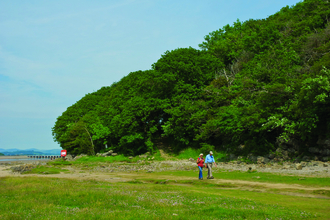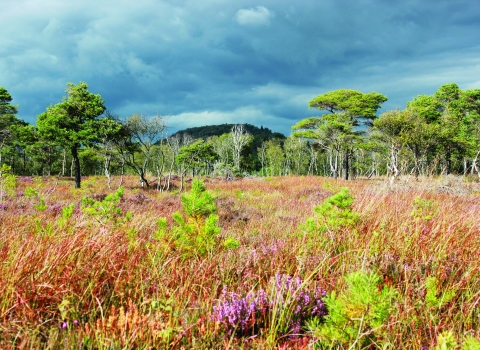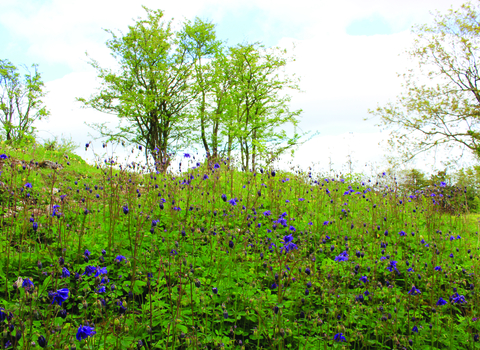
Grubbins Wood
Limestone woodland provides shade for many species of ferns.
Large mounds on the woodland floor are home to southern wood ants.
Location
Know before you go
Dogs
When to visit
Opening times
Open all year roundBest time to visit
April to July and September to NovemberAbout the reserve
Wildlife highlights
- Red wood ants are active in spring and summer feeding on honeydew produced by aphids in the tree tops – they go into hibernation in winter. Don't miss the southern wood ants busy carrying food to their large nest mounds in the summer.
- A display of meadow flowers including dropwort, betony, salad burnet, bird’s-foot-trefoil and lady’s bedstraw add summertime cheer to Pickles Meadow
- Hart’s-tongue fern is one of 24 species found in the dark, damp microclimate of the wood
- Bluebell and wild garlic carpet the woodland floor in spring and greater butterfly and spotted orchids are in flower.
- In autumn you can see bright red berries on the Lancastrian whitebeam.
- Winter is the time to spot waders and wildfowl down on the foreshore.
- Witness the phenomenon of the Arnside Bore - an impressive tidal wave - a couple of hours before a high spring tide.
- If you are really lucky you may see a local osprey fishing in the estuary.
Ancient woodland
Woodland has probably been present at Grubbins Wood since medieval times although historically it would have been coppiced for timber.
Today, impressive stands of yew grow on extremely thin soils and cast a deep shade throughout the year so that little can grow beneath.
Elsewhere, oak, birch and ash are common, beneath which flowering bluebell, dog’s mercury and wild garlic signal the start of spring.
The low cliffs above the shore is the place to find the Lancastrian whitebeam. This incredibly rare tree is only found around Morecambe Bay.
Ferns, such as hart's tongue fern, love the dark, damp microclimate of the wood and 24 species have been recorded here.
What makes Grubbins Wood so special?
Grubbins Wood is home to a variety of plants and insects that are rare in Cumbria.
Small-leaved limes are large, old trees that grow along the bottom of Sands Field, whilst Lancastrian whitebeam, is found on the low cliffs above the shore.
Red wood ants make nests here at their most northerly location in Britain.
Southern wood ants
Look out for the large mounds on the woodland floor which are the nests of southern wood ants.
The ants build nests from leaves and other material in sheltered, sunny spots.
They are most active in the spring and summer but they retreat underground for the winter.
Meadow flowers
The nature reserve has two areas of grassland, Pickles Meadow and Sands Field.
Pickles Meadow is the most diverse with dropwort, betony, salad burnet, bird's foot trefoil, lady's bedstraw and knapweed.
Keeping it special
Grubbins Wood has been managed by the Trust since 1974 and leased from the Matson Grand Estate since 1978. The fields are grazed annually to encourage the flowering plant species. We carry out limited management in the wood itself.
Getting here
Grubbins Wood can be reached on foot from the centre of Arnside. At the end of the promenade, follow the public footpath along the shore for 0.7km/0.5 miles passing Ash Meadow and the Sailing Club. (N.B. Uneven in places and not always accessible at high tide).
The reserve can be accessed via a stile just beyond the Sailing Club’s slipway. Alternative access is via Red Hills Road and New Barns Road.
By bicycle:
The reserve is 1.5km/3 miles from National Route 700 The Bay Cycleway and 5km/3 miles from National Route 6 Greenwich to Keswick.
By public transport:
Trains run from Lancaster, Barrow-in-Furness, Ulverston and Grange-over-Sands to Arnside. Buses run from Kendal to Arnside.
Species
Habitat
Contact us
Did you know?
Yew trees are amongst the longest-lived trees in the UK, often reaching 600 years of age, though some are estimated to be thousands of years old.
Upcoming events at Grubbins Wood Nature Reserve
If there are any upcoming events at Grubbins Wood Nature Reserve we'll show them to you below.

Support our conservation work on this nature reserve,
and protect Cumbria's wildlife & wild places.








